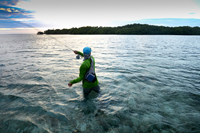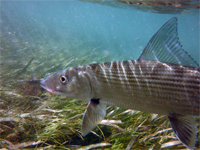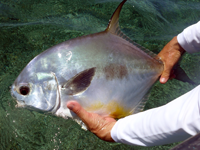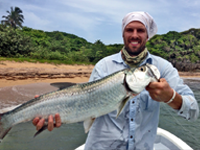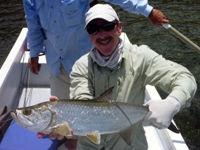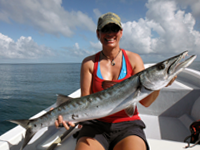Fishing at Mango Creek Lodge Additional Activities
Overview
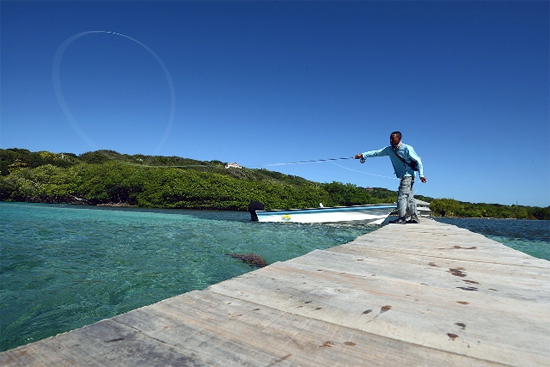
MANGO CREEK LODGE IS PROUD TO BE ROATAN'S PREMIER SALTWATER FLATS FISHING DESTINATION.
In Roatan you can fish for: Bonefish, Permit, Tarpon , and Snook.
Roatan fishing offers a unique combination of plentiful, healthy flats beneath a backdrop of lush, mountainous terrain, and Mango Creek Lodge is ideally situated to take advantage of both. Located in secluded Port Royal on Roatan's East End, Mango Creek Lodge is close to Roatan's most productive flats for fishing for Bonefishing and Permit. In fact, our Breakfast Flats are visible from our front door. Just a short 60 second boat ride away or a 10 minute kayak, if staying at our resort.
We offer daily guided fly fishing and spin fishing on the turtle grass flats of Roatan's East End as well as the nearby islands of Morat and Barbaretta. Mango Creek Lodge's primary targets are the saltwater “grand slam” species: bonefish, permit, and tarpon. However, while here, you can also try your luck fishing Roatan for barracuda, jacks, and snook. Spin fishermen will also enjoy the opportunity while fishing Roatan, to cast at numerous species in the East End's harbors and mangrove canals.
Mango Creek Lodge tailors its fishing days around your schedule. You are free to fish at your leisure between sunrise and sunset. Our experienced, local, English-speaking guides are at your service throughout your stay and are happy to coach you if you are new to fishing Roatan.
Mango Creek Lodge is proud of our commitment to the local economy, we use only local guides. Our guides are very personable, respectful and knowledgeable about the local waters. Our guides are committed to making your experience a memorable one whether you are a seasoned vetern of fishing or a beginner.
Mango Creek Lodge is dedicated to preserving the health of Roatan's flats. We are working with local communities to develop environmental education campaigns and have made progress in our efforts to eliminate illegal netting, all to make fishing Roatan better. In addition, to minimize pressure and ensure the continued success of our operations, we limit ourselves to four skiffs (or eight anglers) fishing Roatan on the flats each day. We can put any number of other fishing Roatan guests out in more boats when not on the flats.
Learn more about saltwater flats fishing at Roatan's Mango Creek Lodge by exploring the links below. For even information about Roatan's fishing conditions and what kind of gear to bring, see Mango Creek Fishing Guide.
Image (top right) furnished by “Brett Schreckengost” photography
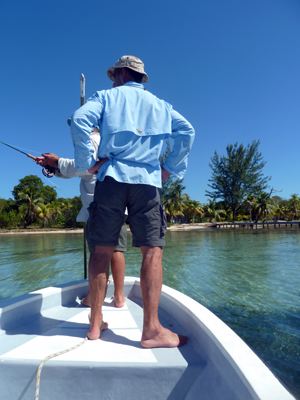
FISHING GROUPS
Fishing Roatan's flats and reefs from Mango Creek Lodge is restricted to small groups, this is to ensure the experience for each person. When fishing Roatan, almost always, Bonefish are nervous, they are on the bottom of the food chain, sharks, barracuda, even osprey feed on Bonefish. To ensure a great fishing experience for our guest, we limit fishing the flats to four boats. Our guides also try not to hit the same flats on the same day, again to lessen the impact of fishing.
BOATS
Mango Creek uses Panga style boats for fishing. The panga design is long and narrow, keeping you dry in even the large swells. They also allow for a more solid stance when casting on the deck.
REPORTS
Want to know the latest fishing news at Mango Creek Lodge? What's biting? How's the weather? Check out our blog to find out what's happening!
Have a great photo from your recent stay? We'd love to include it in our next post. Please send photos and messages to us at [email protected]
Fly Fishing
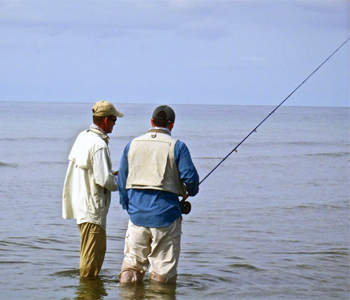
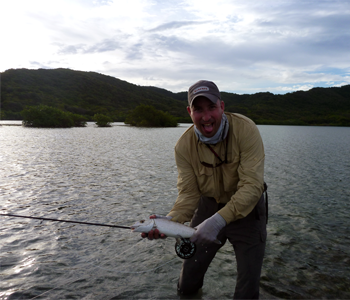
Saltwater fly fishing is the emphasis of Mango Creek Lodge's fishing operations. Roatan's numerous East End flats present the challenges and opportunities of hooking up the coveted saltwater “grand slam.”
Mango Creek Lodge's fly-fishing guests do most of their fishing by wading Roatan's turtle grass and coral flats. However, you may also spend time fishing by boat in the island's mangrove canals and shorelines. Your guide will help you spot and stalk the grand slam of bonefish, permit, and tarpon as well secondary target species such as jacks, barracuda, snappers, grouper, and queen triggerfish.
While staying at Mango Creek Lodge you are always welcome to fish on your own as well. The breakfast flats are just a short kayak paddle away!
Spin Fishing
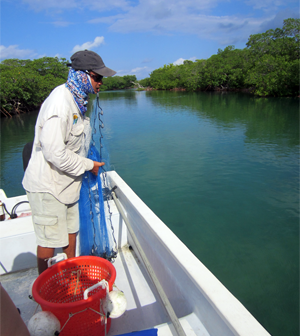
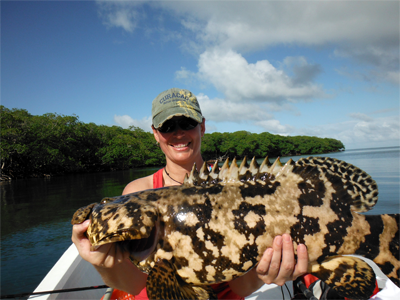
Mango Creek Lodge’s spin-fishing guests wade Roatan’s saltwater flats and explore the mangrove canals and harbors in our 18-ft skiffs. Your guide will help you spot and stalk the saltwater grand slam of bonefish, permit, and tarpon as well secondary target species such as jacks, barracuda, snappers, grouper, and queen triggerfish. In addition, you can try your luck at passing schools of tuna, wahoo, sailfish, and marlin.
This is great fun for everyone. And what do we use for bait, you ask? Minnows and hermit crabs.
Make sure you gear up with the appropriate rods, reels, line, leaders, and tackle.
We do have gear you can use, if you do not bring your own. And one of our fishing guides will be more than happy to catch live bait for you.
BONEFISH
Bonefish are easily catchable on spinning tackle—especially if you tip your jig with a piece of dead shrimp. For bonefish, bring:
- Phillips Gaines wiggle jigs, 1/8 oz and 3/8 oz, in light tan, pink, yellow, olive, and white
- D.O.A. Shrimp (the smaller, the better).
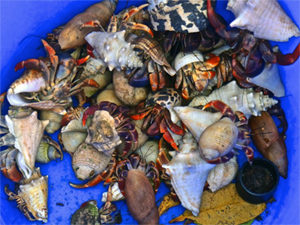
PERMIT
The best bait for permit is a live crab, although some permit are caught on the flats with jigs. For permit, bring:
- Owner MUTU hooks 1 and 1/0
- Gamakatsu Octopus hooks 1 and 1/0
- Wiggle Jigs (see above)
- D.O.A shrimp, tan and olive, 1
- D.O.A. crabs, tan and olive, 1.
TARPON
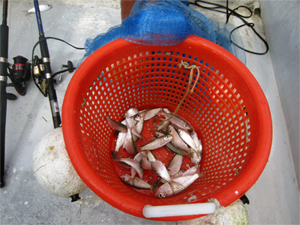
The best bets for tarpon are live bait. Very rarely does a tarpon pass up a struggling sardine. For tarpon, bring:
- Owner AKI hooks 3/0
- Gamakatsu Octopus 2/0
- Gamakatsu Octopus Circle 4/0
- Super Zara spook red/white and mullet
- Saltwater Rapala Fire Tiger
- YO-Zuri Crystal Minnow, black and silver
- Rat-L-Trap Mag, blue and silver, yellow
- Mirror Lure 52m, red and white, yellow, black and silver.
RODS
A variety of rods can be used in Roatan's waters. Consider bringing:
- Light-Medium Light, 5.5-7 ft
- Medium Light-Medium, 5.5-7 ft
- Medium, 5.5-7 ft
- Medium Heavy, 5.5-6.5 ft.
- REELS
- Brings reels of 150 yd, 250 yd, 200 yd, 175 yd.
LINE
Possible line varieties are 6, 8, 12, 12-20, and 15-25 lbs.
LEADERS
Pack mono 60-80 lb & 100 lb for barracuda, 6-18-in wire, and 30-50-lb test.
Day Fishing
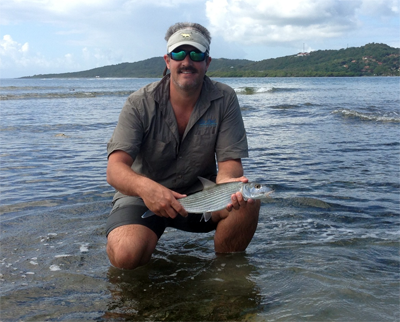
COME FISH FOR THE DAY

If you're coming to Roatan but not staying on the East End, you can still explore the saltwater flats with Mango Creek Lodge by booking a day of fishing. Our day-fishing package includes guided fishing, a warm breakfast, sack lunch, drinks (water, soda and beer), and transfers to and from the town of Oak Ridge.
Your guide will pick you up at BJ's Backyard in Oak Ridge at 7:00am, before whisking you off to a nearby flat. After a bit of fishing, you'll stop by the lodge for a nice breakfast in our restaurant. We will have a cooler packed with your lunch and cold beverages. Then you will head back out on the water for the remainder of the day. Your guide will drop you back off at BJ's, in Oak Ridge, at 5:00pm.
Your hotel can help you arrange taxi service for drop-off and pick-up in Oak Ridge. If you need help, we can recommend or arrange a taxi for you.
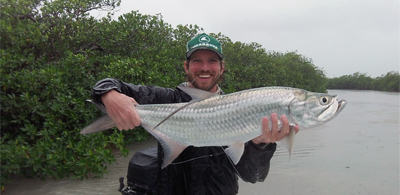
DAY-FISHING RATES:
1 person with private boat & guide: $350 + tax
2 people with shared boat & guide: $525 + tax
Non-fishing companion: $50
For more information and availability, please send an email to us at: [email protected]
Our Guides
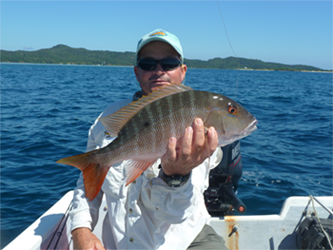
Guide Perry Cooper
Perry is one of the best guides anywhere and has a lot of people saying that. He has been fishing Roatan’s East End for many years, both fly fishing and spin fishing. He and all our guides fish exclusively for Mango Creek Lodge. Perry goes beyond guiding, I have seen him make people catch fish. Ask anyone who has fished with Perry and they might mention that hand, that quietly reaches over to stop you lifting that rod tip, instead of strip setting the fish.
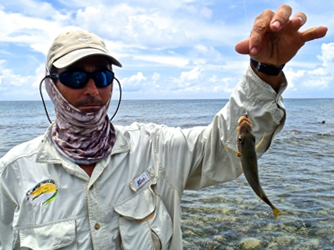
Guide Kessel Cooper
Kessel, Perry's brother has been fishing almost as long. He has one of those dry English types of humor, and you can easily be the brunt of it without even noticing while fishing Roatan. Later when it comes around again you will catch it and the game is on. It is not uncommon to hear laughter coming in a steady stream from Kessel's boat.
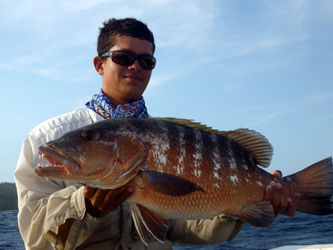
Guide Joevy Bodden
Joevy, our youngest guide shows that we will have a great future. What Joevy lacks in experience he makes up for in enthusiasm. When the fishing is off Joevy gets going, he is never down, he is spectacular at both fly & spin fishing. Fishing Roatan is a changing game, what worked yesterday might not work today and vice- versa. That is when Joevy shines his brightest.

Guide Davy Bodden
Davy is one half of the fishing twins. Born and raised in Oak Ridge, he grew up Flat hoping and is a great guide on either spin or fly fishing. With his knowledge and great attitude he will have guest on top of fish before they know it.

Guide Devin Bodden
Devin, the other fishing twin, is as knowledgeable as his brother. Great on the waters, both personable and corteous, he will make a fishing day a real adventure. He is known to not let on until you land that big one!
Fishing Guide
 The following guide is meant to serve as a printable introduction to the world of saltwater fishing at Mango Creek
Lodge. It should answer some basic questions and give you an idea of what to expect before coming. This is by no way a
definitive manual, but is essentially anassessment of how we approach fishing.
The following guide is meant to serve as a printable introduction to the world of saltwater fishing at Mango Creek
Lodge. It should answer some basic questions and give you an idea of what to expect before coming. This is by no way a
definitive manual, but is essentially anassessment of how we approach fishing.
(DOWNLOAD AN ADOBE® PDF VERSION OF THIS GUIDE...)
The Fish
SPECIES
The three target flats species; tarpon, bonefish, and permit are all found at Mango Creek and share very similar traits and feeding habits. They are fantastic fighters and each poses their own challenges for hooking and landing. Although these are our primary targets, there are countless other species that are worth searching for on the fly or with conventional tackle. There are seemingly endless supplies of snappers and grunts, groupers- ranging from a couple of ounces to the famed 800 pound Colossal Grouper, 6 different species of jacks, cobia, barracuda, snook, triggerfish, and more.
Bonefish
Bonefish are perhaps the most ideal light tackle inshore salt-water gamefish. Smaller schooling fish give novice anglers honest chances at hooking fish and larger cruising singles can provide the ultimate challenge even for the most experienced anglers. Additionally, they readily take retrieved flies and once hooked their blistering runs are nothing but amazing for a fish their size. Shrimp and small crustaceans are their primary forage they seek on the flats.
Tarpon
Perhaps the largest gamefish in the world that will readily take a retrieved fly, tarpon are the tops when it comes to inshore fly fishing. Sometimes they prove too incredibly finicky and other times they will eat anything presented to them. Long freight train like runs combined with fantastic acrobatics and sometimes frighteningly aggressive takes make tarpon an awesome quarry. Tarpon feed primarily on baitfish but are known to eat different varieties of oceanic worms, crabs, and mollusks.
Permit
Without a doubt the most difficult fish to catch on the flats. Typically a deeper water fish, permit frequent flats in search of crabs, shrimp, and other crustaceans. Their penchant for deep water creates an inherent nervousness while in shallow water making permit often very difficult to approach. Combined with an excellent sense of smell and great eyesight, permit are the ultimate challenge. Our success with Permit here at Mango Creek is unheard of in this industry but please remember some great fishermen have never caught a permit, but you’ll see plenty here.
Snook
Snook are primarily a river and brackish water fish although they have been known to visit our flats and mangrove lagoons. Designed as an ambush predator they are most often seen with only their noses poking out from the mangroves but also occasionally cruising the edges of channels, shorelines, and edges of flats. Snook are best known for their aggressive strikes, acrobatics, and never give up attitude. Baitfish are the primary prey for snook.
Barracuda
The vice-president of the flats so to speak. Ambush predators as well, barracuda will typically remain perfectly still waiting for unsuspecting bait to pass by and then explode upon their prey. Being opportunistic feeders, barracuda will usually chase anything that is trying to get away from them. The resulting strike and run can only be described as fantastic; brutally fast and long runs with greyhounding jumps.
Jacks
Crevalle, horse-eyed, bar, and blue-runner all have one thing in common- pound for pound they are perhaps the strongest fish on inshore flats. Finding a school of aggressively feeding large crevalle jacks is a sight to behold. When these fish are on the feed, nothing is safe in the water.
Snapper
There are countless varieties of snapper in the Caribbean ranging from tiny schoolmasters to big bad Cubera snappers that can weigh up to 100 pounds. Mutton, grey, and lane snapper are often caught on the flats and yellowtails and others on the reef. Occasionally a cubera will be hooked while fishing with bait in the channels, but rarely are one of these fish landed. All snappers are opportunistic feeders.
Grouper
Grouper are a bottom dwelling ambush predator. Typically they reside in caves and wait for unsuspecting prey to swim by. Grouper are known to leave their caves and chase a trolled plug, jig, or bait. Landing a big grouper is a whole different issue than hooking one.
Sharks
Small sharks are a regular sighting on our flats. Nurse, lemon, blacktip, and reef sharks enter the shallow waters in search of an easy meal. Blacktips are the best gamefish of the lot; providing long runs and twisting jumps.
BEHAVIOUR
There are four main behaviors of bonefish, permit, and tarpon
- Tailing: (Does not happen with tarpon). Seeing a fish tail is truly a unique sight. The process of tailing involves tipping their body so their mouth is in contact with the bottom and their eyes are tilted so that they can see what they are feeding upon. Tailing fish are actively feeding, therefore greatly increasing odds of hooking up. However, there are some basic common mistakes that anglers make while casting to tailing fish. First, when a bonefish is nose down in the bottom they have a very small window of peripheral vision requiring an accurate presentation generally within a few feet. Second, tailing fish are inherently spooky because they are in shallow water, and the more tailers there are the greater the chance of spooking the entire school. Third, anglers often cast over a non-tailing fishing causing the rest of the school to blow out. Things to remember: accurate close casts, delicate presentation (lightly weighted flies with weed guards), and make sure there are no unseen fish between the angler and the rest of the school. However, if they do spook do not fret, tailing fish will often resume their feeding at near the exact location after a short while.
- Mudding: Mudding fish provide the most sure-fire way for an angler to hook a bonefish. Mudding is defined by having a good number of fish actively feeding in deeper water, it is really just fish tailing under water. Consequently, the bonefish stir up enough of the bottom to actively conceal individual fish as well as allow the boat angler to approach at usually impossibly close distances. Additionally, having so many fish actively feeding generally creates competition for food and the turbid water often masks heavier tippet and indelicate presentation. Problems with muds: they often attract a good number of sharks and barracuda, muds require the use of heavily weighted flies in order for the presentation to be within the “red-zone,” muds generally will hold only smaller to medium sized fish of similar size (see “schooling behavior”) and most anglers consider fishing muds to not be the true Bonefishing experience. On the positive end, muds give even the unaccomplished angler a very good chance of hooking fish, possibly even a permit. The best way to fish muds is generally to stake out up current and cast down towards them, fishing the front edge to back. One must allow the fly adequate time to sink and retrieve the fly away from the fish, not towards them. Tarpon equivalent is busting bait on the surface.
- Cruising: Cruising fish generally present the greatest challenge to the angler. First, they are not necessarily feeding, second they tend to be very spooky and unforgiving (unlike tailers), and third they tend to be the bigger smarter fish. Fishing for cruisers generally involves placing the fly significantly in front and away from the path of the fish and timing the retrieve so that the fly is traveling away from the fish when it reaches the fish’s “red zone”. Flies that are retrieved towards a fish often spook the fish, because that is an unnatural prey action. Cruising fish can be the most difficult and the most rewarding.
- Laid Up: The final behavior is one shared by most species of schooling saltwater fish. Generally this happens at high slack and high out-going tides. The school will congregate tightly in deeper water and “float” just under the surface. Sometimes these fish will attack anything presented and other times they will eat nothing.
Equipment and Gearing Up
FLY FISHING
Fly Patterns
There are some basic concepts one wants to adhere to when selecting flies for any fish. The fly must resemble the fish's preferred prey in profile and size. The fly must look “alive” in the water, and color should match the natural bait we are trying to mimic. However, in saltwater no rules are definite. Being lifelike and presenting a feasible size and profile is imperative, but color is a variable that we can alter to our benefit.
- Color: Common knowledge on the flats suggests that our imitations should match the color of the bottom, thinking that if the bait is not able to blend in with its surroundings it cannot survive. So if a shrimp cannot blend into its surroundings what is its future? It will get eaten. This is precisely why colors such as hot pink and chartreuse are effective on the flats. Fish are thought to only see monochromatically although some colors, such as chartreuse and pink, are thought to stand out better than other colors.
- Flash: The flash in a fly helps to attract the attention of predatory fish and add to its lifelike characteristics. Prey such as shrimp that are nearly transparent benefit from a little bit of flash, which suggests the movement of their many legs and feelers. Prey such as small baitfish benefit from more flash representing their generally shiny scales. Prey such as crabs should have the least amount of flash being that they are the slowest moving of the prey and depend more on camouflage and their hard shells for protection rather than their speed for flight.
- Profile: Profile and shape of the fly is generally one of the primary factors of fly selection. Every other factor can differ, but the fly must look and move like prey.
- Size: Usually as similar to the natural as possible. Although in some circumstances we must vary our size significantly; in muds- a great big clouser minnow may be the best bet to keep off the small ones, in skinny water with super spooky schools - the smaller the better, and with big fish cruising the flats it is generally not worth it to them to chase something down that will not fill their belly.
- Action: If the fly looks dead in the water it will not catch fish, period. This is one of the factors that makes fly-fishing for permit so difficult. Crabs, their preferred prey, generally do not move if they are threatened and a fly when it does not move will pretty much look like a ball of feathers and nothing more. Some materials perform better than others; it all depends on the prey you are trying to imitate.
- Acoustic Footprint: Although a relatively new concept to fly selection, the acoustic footprint if utilized correctly, can greatly benefit or hinder the angler. The concept behind this is that regarding how the fly is “dressed” will effect the amount of water the fly pushes, a sense that fish pick up very quickly along their lateral line. Concepts to remember with this; skinny water- skinny flies. Deep or muddy water, big and bushy flies. Sparsely dressed flies will “slide” through the water requiring the fish to see the fly in order to know it is there (Snapping Shrimp). Heavily dressed flies, flies with big eyes or a lot of hair, will “push” water (Whistlers). Now all of a sudden the fish can “feel” and see there is food around.
- Hooks: Regardless of fly choice your hook must be sharp. By nature, stainless steel is a soft metal that dulls easily and does not stay sharp for long. Newer chemically sharpened “tinned” steel hooks are proving to be far better on the flats- especially with tarpon. Not only are newer hooks shaped to penetrate and hold fish better, they will also corrode quickly lessening the amount of metal on the sea floor and stuck in fish’s mouths. Circle hooks are quickly becoming the choice of our guides for tarpon. Their design allows for a significantly sharper point, (protected by the circle so it will not dull with impact with bottom or boat) a shape that does not slip nearly as often as conventional hooks, and if fished correctly the hook will lodge in the corner of the fish’s mouth greatly lessening the chance of fish mortality. The key to fishing circle hooks is to not “set” the hook. Pinch the line between your hand and cork and hang on for dear life- the hook will find a soft spot when the fish turns. Currently Daiichi, Mustad, Owner, and Gamakatsu are making great tinned circle hooks.
Line
Generally speaking, most flats fishing will be done with a weight forward floating line. There are some situations where an intermediate, or intermediate sinking tip line will be superior when fishing for large tarpon in the channels. However, 99% of our fishing is done with floating lines. Saltwater specific “tropic” lines are highly recommended. These lines generally have a braided monofilament core, which keeps them dramatically stiffer in hot conditions lessening knotting and tangling while in the boat and greatly reducing frustration and chances of blown opportunities. Scientific Anglers, Rio, Airflo, Monic, Royal Wulff, Cortland, and Orvis are all producing salt specific lines. Some anglers will also benefit from “overloading” their rods with one line weight higher than recommended by the rod manufacturer. This will load the rod better at short distances and in windy conditions often increasing the novice angler’s performance on the flats. Although most new lines do not require daily cleaning, thoroughly rinsing off with fresh water and an occasional cleaning will definitely aid in performance and longevity of lifespan. Clear middle sinking lines are also a must for deeper bonefish and Tarpon and we recommend bringing along at least one. Your guide will ask to clean your gear every night; please remember to let him do his job with your gear, especially your shoes.
Leaders
Leaders effectively transmit and disperse the power created by the fly line, which enables the line to completely straighten out without the fly snapping off. Bonefish leaders generally range in an 8’ to 12’ range depending on the circumstance. Spooky fish in skinny water often demand long leaders and delicate presentation; although in wind it is impossible for most to get a long leader to straighten completely. Therefore shorter leaders benefit the caster. Butt diameter of a leader also affects the turnover rate. Too stiff of a butt and a great deal of power is required to turn over the fly. Too soft and too much power is dispersed and the fly cannot turn over. Keys to remember: spooky fish require a long leader. High wind and heavy fly means you should shorten the leader. If the line is still not turning over, add a stiffer butt section. Permit leaders follow the same concept. We typically fish long leaders for permit (12’) ending in 2-15 pound test. Bonefish, typically a 9’ 10 pound test leader will do.
Tarpon leaders are a whole different sack of worms. A typical tarpon leader consists of 5 feet of heavy butt section material (typically 40-50 pounds) than connected via loop to loop to an 18” section of class tippet (16-26lb) and then a 16” section of shock tippet (60-100lb). The heavy shock tippet will prevent the line from cutting on the tarpons sharp gill plates and the class section provides a weak link in the line, providing a breaking point so neither the fly rod (even twelve weights break around 25lbs of pressure) and fly lines (most break around 30 pounds) are lost.
Snook require shock tippets as well to protect against their razor sharp gill plates. Typically 20-40 pound test shock is sufficient. Barracuda and sharks require wire shock tippets. A big ‘cuda will slice even through 100 pound shock like nothing. The shorter you can get away with the better. Jacks, although they have small teeth, typically do not require wire leader but heavier mono tippet 15-25 lbs will definitely decrease numbers of lost fish.
There are generally two types of leader/ tippet readily manufactured, nylon monofilament and fluorocarbon. Mono has been around for decades and is generally the standard. It can be manufactured in different ways to create a softer, more supple line or a stiffer more abrasion resistant line. Mono is also readily tinted and can be any color ranging from clear to fluorescent pink. Fluorocarbon is a relatively new product on the market and boasts properties that lead one to believe it is a superior product. Attributes include; fluorocarbon has a refractory index almost identical to water making it effectively “more clear” and less visible to fish. Flourocarbon is stronger than most monofilament in regards to diameter to strength. Flourocarbon is also very abrasion resistant, and it is significantly denser than water allowing a faster sink rate than mono. On the down side; fluorocarbon is significantly more expensive, it does not stretch as much, and knot strength is compromised if the knot is not perfectly lubricated and seated. There are applications where fluorocarbon is superior, such as skinny water and spooky fish. However, for the most part premium monofilament will provide consistent results at significantly less cost.
Knots
Without good knots one is dead in the water. One does not need to know them all - but a good selection of the basics will cover most situations.
- Uni-Knot: For attaching line to backing.
- Nail Knot: Attaching leader to line. You should bring a nail knot tool.
- Blood (Barrel) knot: For general construction of leaders. In heavier leader (20-40lb) sizes 3-4 turns is sufficient. In smaller sizes (20-10lb) 4-5 turns, and less than 10lbs 6 turns. Exceeding six turns weakens the knot by making it not sit correctly.
- Double and Triple surgeons: Although bulkier than blood knots, they are quicker to tie and about as strong. Good for tying different types of material together (flouro-mono) and for smaller diameter lines.
- 8 turn un-improved clinch: Proven to be the strongest tippet to fly knot around. More than eight turns and it will not sit right. Less than eight turns and strength is compromised.
- Improved Clinch: Greater than 20lb three turns, 15-20lb 4 turns, 10-15lb 5 turns, 5-10lb six turns.
- Bimini Twist: Construction of tarpon leaders. Effectively doubles the class tippet while remaining at 100% strength. This comes into play for attaching shock tippet to class, and class to butt section- all the while remaining at least 100%.
- Huffnagle: Used for forming the “Immaculate Connection,” attaching Bimini in class tippet to heavy shock tippet.
- Important keys to remember with knots; always lubricate before tightening (saliva works great), tighten in a steady pull not a sharp tug, and hold pressure on both ends of line for at least 5 seconds to fully seat the knot. With knots for tarpon it is beneficial to leave a slightly longer tag end then usual. A large tarpon will put more strain on knots than we are able to by hand. A longer tag end will allow for the knot to tighten further without slipping.
Fly Rods
In general, fly rods for saltwater flats fishing are stiff, fast action graphite rods in weights 6-12. Softer and slower action rods in these weights will suffice- however they will lack the power necessary to punch the fly out in a stiff wind or turn a speeding fish. On the flats an eight-weight is standard for bones. In low wind conditions one can get away with a six weight and high winds may require a stout nine-weight overlined with a #10. A nine or ten weight works great for throwing large shrimp or crab patterns to permit. For most of our resident tarpon (20-50 pounds) a ten-weight will reduce casting fatigue and still do the trick, but an 11 or 12 is necessary if you want to tackle the big boys. Rods within the 8 ½ to 9 ½ foot range are well suited with 9 footers being the norm. All major rod manufacturers are currently producing saltwater specific rods in higher end models and entry level. Some are better than others, few are bad. Some of the best are: Sage Xi2, Winston BL5, Thomas and Thomas Helix and Vector, Scott S3s, Powell Tiboron, G. Loomis GLX...
Within the last years rod technology has improved to the point where the addition of more than one ferrule does not affect performance. Travel benefits associate with multi-piece rods are countless. There is nothing worse than having your brand new salt stick not show up at your destination. When assembling rods, start with the guides at right angles and twist and torque down until the guides align. This will “lock down” the ferrules and lessen the chance of slippage. It is very important to check the ferrules on rods, they loosen quite often and create a weak spot where the rod is apt to break. Always rinse rods after saltwater use.
Fly Reels
Unlike the trout reels that most anglers are accustomed to fishing with, a smooth and powerful drag is imperative to the landing of larger fish. Large cork drags have proven to be an industry standard and composite drag surfaces have gained popularity in recent years. Large arbor reels have proven their worth on the flats enabling a greatly increased line retrieval rate, which means fewer lost fish. Generally, a bonefish reel should have at least 200 yards of 20lb backing in order to be prepared for the worst and it is wise to have to have up to 300 yards for the big tarpon. It is a good idea to keep the neoprene protective covers on the reels during all travel period- bent and banged up frames are nearly impossible to fix on the water. Thoroughly rinse reels after each saltwater use and clean and lube them to the manufacturer's recommendations at the end of your trip.
SPIN FISHING
Rods
Once again fast action stiff spinning rods are well suited to fishing the flats. Rods of at least 6 feet are well-suited and 7 footers near perfect for all species on the flats. For bonefish and most permit light-medium action rods rated for lines 6-12 pound are great. Any salt-water safe spinning or casting reel equipped with 200 yards of 6-10lb monofilament line and you are in business. When casting small jigs and bait, the limpest and lightest line is best (i.e. 6lb Maxima Perfexion, Ande Backcountry). For permit and snappers on the reef medium action rods rated for roughly 10-20 pound test and reels rigged with 200 yards of 12 or 15 pound test. Rods for tarpon, snook, large jacks, barracuda should be medium to heavy action and rated for roughly 12-25 pound test. For tarpon and barracuda braided lines (Power Pro, FireLine…) are gaining popularity allowing a great deal of line to be on smaller reels and they cast excellently. 15-20 pound monofilament also works great. Even with spinning rods you will need a heavy shock tippet section for the tarpon and wire for 'cuda. And if using braided lines for bones and permit you will need a roughly 2 foot “tippet” of 8-12 pound test mono or fluorocarbon for presentation purposes.
Notes on spinning rods: Even the most diehard and experienced saltwater fly fisherman often bring a spinning rod in the boat rigged with wire trace for barracuda, sharks, and jacks. These large predatory fish are regularly seen cruising the flats and can spark up a seemingly dull afternoon.
Lures
The standard bonefish lures are typically referred to as “Wiggle Jigs.” These are small lightweight, flathead jigs. Their broad head does not let them to sink as fast as bullet head or round head jigs effectively keeping the jig in the bonefish's “strike-zone,” longer.
Manufacturers such as Millies, Gaines, Cabelas, and Bass Pro Shops make good versions. Lighter colors such as white, tan, and pink tend to work better. The lightest jig you can effectively cast with your rod and reel will be best, these are typically the 3/8oz or 1/4 oz versions, although it is a good idea to have multiple weights for fishing different depths. It is typical practice to tip wiggle jigs with a small piece of dead shrimp.
Tarpon lures should be in the 3-5 inch range with heavy trebles made to run at depths less than 3 feet are standard on the flats. MirrorLure, Rat-L-Trap, types shaped like sardines are great. In the channels and along the reef longer lures that run deeper are often the trick. Rapalas, Bombers, Yo-Zuris that will troll/ be retrieved at a depth from 5-10 feet. Colors of lures are typically not as important as the action and depth. Colors that have proven themselves are typical black/ blue and silver, “Fire Tiger” banded orange and chartreuse, red headed and white, and yellow. Top quality heavy hooks and stainless split rings are absolutely imperative. Rubber baits, both typical thumper tail rubber shad with lead heads (3-6”) and newer “Living Eye,” and stick baits such as Fin-S are gaining popularity and keep the cost of hardware down. It is also not a bad idea to have a popper or two in your box. Super Spooks and other large poppers can be deadly not only on tarpon but jacks, barracuda, and sharks. Hands down the best lure for 'cuda is a surgical rubber tube lure from 10-20” long in either florescent green or red. Very rarely does a barracuda refuse one of these.
When the jacks are on the flats and reef they typically are not too selective. The lures you will have for tarpon will be sufficient. However, it is a good idea to have some heavy casting spoons for making long casts to these difficult fish. For ladyfish in the reef cuts and on the flats it is also a good idea to have some silver spoons in the 2-4 inch range and some lead head jigs with rubber curly tails. Snook will also eat typical tarpon lures and can be an absolute blast on poppers. Fishing on the reef is done with light 1/4oz-1/2oz egg shaped slip sinkers and hooks in the 1-2/0 size range.
One final note: traveling with fishing gear can be a nerve wracking experience. Most fisherman don't feel comfortable checking rods and flies before boarding a flight for fear of them being damaged or lost in transit. In our experience, most airlines are accommodating and will allow you to carry-on four (or even three) piece rods as well as boxes of flies. Be sure to check with your airline ahead of time and take whatever steps necessary to avoid checking these delicate and expensive items. There's nothing worse than arriving excited to fish and finding out that your gear hasn't made it or has been damaged.
If you have any questions concerning Mango Creek contact us via e-mail at [email protected] . You can also reach us by phone at (303) 647-9605 (USA) or International Access Code + (504)-891-687-04 (HN).
Mango Creek Lodge Fishing Reports

Want to know the latest fishing news at Mango Creek Lodge? What's biting? How's the weather? Check out our blog to find out what's happening! Please go to our Blogs for recent fishing reports
Have a great photo from your recent stay? We'd love to include it in our next post. Please send photos and messages to us at [email protected]
